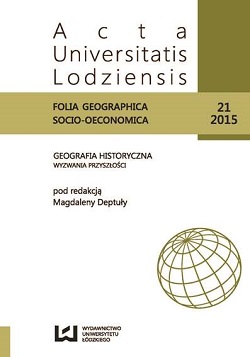Spatial differentiation of results of the Polish parliamentary elections 1957
DOI:
https://doi.org/10.18778/1508-1117.21.04Keywords:
election 1957, the spatial diversity, sustainability of electoral behavior, Polish United Workers Party, constituenciesAbstract
When comparing the spatial differentiation of results of elections from the inter-war period (1918–1939) and the post-communist period (1989–2015), one sees a very clear similarity between the two (Kowalski, 2014). In the north-western part of the country the electoral preferences are with the left or the liberals, while in the south-eastern part – with the right. Given the persistence of this spatial setting, a supposition arises that the spatial differentiation of the political attitudes existed also during the times of the socialist People’s Poland. Lack of political freedom and electoral falsifications, performed by the communists, make the verification of this proposition quite difficult. Of the elections, organised in the socialist period, it is the ones, carried out in 1957, that deserve consideration, first of all. These elections were carried out in the short period of liberalisation after 1956, in conditions of an enthusiastic support for the new governing administration. The organisers of the elections could be fairly certain as to the outcome. That is why, side by side with the candidates, who were closely connected with the ruling establishment, also more independent persons, frequently enjoying high popularity in the society, were allowed to stand as candidates in these elections. In order to guarantee the victorious outcome, the authorities allowed for the formation of just a single list of candidates. The authorities lanced the appeal to vote for the candidates from the first places on the list, since it was on these places that the persons most convenient from the point of view of the establishment were listed. The few independent candidates were located at far-off positions. There was also an appeal for the possibly highest turnout at the elections, since this would constitute a signal of support for the new administration. These appeals were also shared by the Catholic Church in Poland. Despite the limitations and constraints mentioned, the relatively liberal atmosphere was conducive to the electoral competition within the framework of the candidate lists approved. This was yet enhanced by the fact that candidates represented, formally at least, various political organisms (communists, peasant activists, democratic party, non-aligned candidates) and communities, and, as indicated, the lists also included, even though on far-off places, persons of independent orientations. In addition, the liberal atmosphere and the conviction of the ruling group that they must win, limited, it appears, the electoral falsifications to the minimum. Owing to the advantageous social atmosphere and the appropriate construction of the lists of candidates, the communists could not lose these elections. Yet, in spite of this, the official results of the elections made visible the significant differentiation of the Polish society, both in global terms, and in space. The latter aspect represented a clear similarity to the spatial differentiation of the results of elections, taking place in other time periods, both the earlier ones (the interwar period) and those carried out later (after 1989).
References
Bartkowski J., 2003, Tradycja i polityka. Wpływ tradycji kulturowych polskich regionów na współczesne zachowania społeczne i polityczne, Wydawnictwo Akademickie „ŻAK”, Warszawa.
Google Scholar
Drabik S., 2011, Wojewódzka organizacja partyjna PZPR w Krakowie w październiku 1956 i w okresie wyborów w styczniu 1957 roku, „Pamięć i Sprawiedliwość”, 1(17), s. 247–261.
Google Scholar
Dudek A., 2013, Historia polityczna Polski 1989–2012, Wydawnictwo Znak, Kraków.
Google Scholar
Iwaniuk S., 1996, Białorusini w wyborach do Sejmu PRL II kadencji 1957 roku, „Białoruskie Zeszyty Historyczne”, 6, s. 130–165.
Google Scholar
Kępiński A., Kilar Z., 1985, Kto jest kim w Polsce inaczej, t. 2, Czytelnik, Warszawa.
Google Scholar
Kowalski M., 2000, Geografia wyborcza Polski. Przestrzenne zróżnicowanie zachowań wyborczych Polaków w latach 1989–1998, IGiPZ PAN, Warszawa.
Google Scholar
Kowalski M., 2014, Czy Wielkopolska była prawicowa? Przestrzenne zróżnicowanie zachowań wyborczych w Polsce w latach dwudziestych XX wieku, „Prace i Studia Geograficzne”, 54, s. 89–105.
Google Scholar
Kwiek J., 2000, Przebieg wyborów do Sejmu w styczniu 1957 roku w województwie krakowskim, „Studia Historyczne”, 43(1), s. 105–124.
Google Scholar
Nowosądeccy kandydaci, 1957, „Dziennik Polski”, 65, s. 1 i 2.
Google Scholar
Obwieszczenie Państwowej Komisji Wyborczej z dnia 22 stycznia 1957 roku o wynikach wyborów do Sejmu Polskiej Rzeczypospolitej Ludowej przeprowadzonych dnia 20 stycznia 1957 roku, 1957, „Monitor Polski”, 5.
Google Scholar
Obwieszczenie Państwowej Komisji Wyborczej z dnia 15 października 1985 roku o wynikach wyborów do Sejmu Polskiej Rzeczypospolitej Ludowej przeprowadzonych dnia 13 października 1985 roku, 1985, „Monitor Polski”, 28.
Google Scholar
Obwieszczenie Centralnej Komisji do Spraw Referendum z dnia 30 listopada 1987 roku o wyniku referendum ogólnokrajowego przeprowadzonego dnia 29 listopada 1987 roku, 1987, „Monitor Polski”, 34.
Google Scholar
Ostrowski K., Przeworski A., 1996, The structure of partisan conflicts in Poland, [w:] Jasinska-Kania A., Raciborski J. (red.), Naród – Władza – Społeczeństwo, Wydawnictwo Naukowe Scholar, Warszawa, s. 185–206.
Google Scholar
Ordynacja wyborcza do Sejmu Polskiej Rzeczypospolitej Ludowej. Ustawa z dnia 24 października 1956 roku (Dz.U., nr 47).
Google Scholar
Stec T., 1957, Duże zainteresowanie prasy krajowej i zagranicznej wyborami w Nowym Sączu, „Dziennik Polski”, 65, s. 1.
Google Scholar
Turek Z., 1957, Co wskazuje przedwyborczy barometr. Telegram z Nowego Sącza, „Dziennik Polski”, 63, s. 3 i 5.
Google Scholar
Wiatr J.J., 1959, Niektóre zagadnienia opinii publicznej w świetle wyborów 1957 i 1958 roku, PWN, Warszawa.
Google Scholar
Wiśmierski F., 1955, Globus składany, „Geografia w szkole”, 6, s. 326–329.
Google Scholar
Wiśmierski F., 1970, Z dziejów szkolnictwa polskiego na ziemiach wschodnich w okresie II wojny światowej (Tajne nauczanie w powiecie czortkowskim), „Przegląd Historyczno-Oświatowy”, l, s. 107–125.
Google Scholar
Z. Gertych wybrany na posła w ponownych wyborach w Nowym Sączu, 1957, „Życie Radomskie”, 68.
Google Scholar
Zarycki T., 1997, Nowa przestrzeń społeczno-polityczna Polski, EUROREG, Warszawa.
Google Scholar
Downloads
Published
How to Cite
Issue
Section
License

This work is licensed under a Creative Commons Attribution-NonCommercial-NoDerivatives 4.0 International License.








